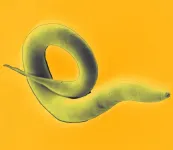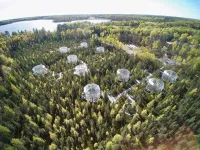(Press-News.org) Using an exceptionally preserved fossil from South Africa, a particle accelerator, and high-powered x-rays, an international team including a University of Minnesota researcher has discovered that not all dinosaurs breathed in the same way. The findings give scientists more insight into how a major group of dinosaurs, including well-known creatures like the triceratops and stegosaurus, evolved.
The study is published in eLife, a peer-reviewed open access scientific journal for the biomedical and life sciences.
Not all animals use the same techniques and organs to breathe. Humans expand and contract their lungs. Birds have air sacs outside their lungs that pump oxygen in, and their lungs don't actually move. For a long time, paleontologists assumed that all dinosaurs breathed like birds, since they had similar breathing anatomy. This study, however, found that Heterodontosaurus did not--it instead had paddle-shaped ribs and small, toothpick-like bones, and expanded both its chest and belly in order to breathe.
Heterodontosaurus is the oldest dinosaur in the Ornithischian line, one of three major dinosaur groups that includes Triceratops, Stegosaurus, and other duck-billed dinosaurs. The other groups are sauropods, or longnecks, and theropods like the T-Rex.
"We actually have never known how these [Ornithischians] breathed," said Viktor Radermacher, lead author of the study and a Ph.D. student in the University of Minnesota's Department of Earth and Environmental Sciences. "The interesting thing is that Heterodontosaurus is the ancestor of this group and it has these [newly discovered] pieces of anatomy, but its descendants don't. What that means is that Heterodontosaurus is a missing link between the ancestors of dinosaurs and the bigger, charismatic species we know. This gives us a whole bunch of information and fills in some pretty glaring gaps in our knowledge of the biology of these dinosaurs."
The researchers analyzed the new Heterodontosaurus specimen with high-powered x-rays generated from a synchrotron--a giant, donut-shaped particle accelerator that spins electrons at the speed of light--at the European Synchrotron Radiation Facility (ESRF) in France. Using those x-rays, they were able to digitally reconstruct the skeleton and identify the dinosaur's unique features.
"The takeaway message is that there are many ways to breathe," Radermacher said. "And the really interesting thing about life on Earth is that we all have different strategies to do the same thing, and we've just identified a new strategy of breathing. This shows that utilizing dinosaurs and paleontology, we can learn more about the diversity of animals on Earth and how they breathe."
INFORMATION:
In addition to Radermacher, the research team included Vincent Fernandez, an ESRF beamline scientist and X-Ray technician at the Natural History Museum, UK; Emma Schachner, an associate professor at Louisiana State University; Richard Butler, a professor of palaeobiology at the University of Birmingham, UK; Emese Bordy, an associate professor at the University of Cape Town, South Africa; Michael Naylor Hudgins, a grad student at the University of Alberta, Canada; William de Klerk, emeritus curator of the Department of Earth Sciences at Rhodes University in Makhanda, South Africa; Kimberley Chapelle, a postdoctoral fellow at the American Museum of Natural History in New York; and Jonah Choiniere, a professor of comparative palaeobiology at the University of the Witwatersrand, South Africa.
The research was funded by grants from South Africa's National Research Foundation (NRF) and Department of Science and Technology (DST), the Palaeontological Scientific Trust, and the Durand Foundation for Evolutionary Biology and Phycology.
Read the full paper entitled "A new Heterodontosaurus specimen elucidates the unique ventilatory macroevolution of ornithischian dinosaurs" on the eLife END
Researchers have shown how worms learn to optimise their foraging activity by switching their response to pheromones in the environment, according to a report published today in eLife.
The findings are an important advance in the field of animal behaviour, providing new insights on how sensory cues are integrated to facilitate foraging and navigation.
Foraging food is one of the most critical yet challenging activities for animals, with food often patchily distributed and other animals trying to find and consume the same resources.
An important consideration is how long to stay and exploit a food patch before moving on to find another. Leaving incurs the cost ...
Synthetic biology offers a way to engineer cells to perform novel functions, such as glowing with fluorescent light when they detect a certain chemical. Usually, this is done by altering cells so they express genes that can be triggered by a certain input.
However, there is often a long lag time between an event such as detecting a molecule and the resulting output, because of the time required for cells to transcribe and translate the necessary genes. MIT synthetic biologists have now developed an alternative approach to designing such circuits, which relies exclusively ...
AMHERST, Mass. - City sprawl and road development is increasingly fragmenting the habitats that many plant and animal species need to survive. Ecologists have long known than sustainable development requires attention to ecological connectivity - the ability to keep plant and wildlife populations intact and healthy, typically by preserving large tracts of land or creating habitat corridors for animals. New research from the University of Massachusetts Amherst argues that it's not enough for ecological modelling to focus on the landscape. If we want the best-possible ecological management, we should consider ...
DURHAM, N.C. -- Plant-based meat substitutes taste and chew remarkably similar to real beef, and the 13 items listed on their nutrition labels - vitamins, fats and protein -- make them seem essentially equivalent.
But a Duke University research team's deeper examination of the nutritional content of plant-based meat alternatives, using a sophisticated tool of the science known as 'metabolomics,' shows they're as different as plants and animals.
Meat-substitute manufacturers have gone to great lengths to make the plant-based product as meaty as possible, including adding leghemoglobin, an iron-carrying molecule from soy, and red beet, ...
Terence D. Capellini has been interested in how joints work for almost three decades. Part of it is due to personal experience, having sustained several joint injuries as a college ice hockey player and recently developing knee osteoarthritis. But the principal investigator of Harvard's Developmental and Evolutionary Genetics Lab has also seen the pain and limited mobility of loved ones who've received similar diagnoses and injuries.
"We have all these joints in the body and they don't look the same from one another," said Capellini, the Richard B. Wolf Associate Professor in the Department of Human Evolutionary ...
Pediatric melanoma is a rare disease with only around 400 cases diagnosed in the United States every year. To better understand this disease and how best to treat it, St. Jude Children's Research Hospital scientists created a registry called Molecular Analysis of Childhood MELanocytic Tumors (MACMEL). A paper on findings from the registry was published today in Cancer.
"What is different about the MACMEL registry is that it is prospective," said corresponding author Alberto Pappo, M.D., St. Jude Solid Tumor Division director. "We're seeing the vast majority of enrolled patients as part of the melanoma clinic at St. Jude. We can follow these patients and conduct detailed pathology and molecular analysis."
More ...
University of California San Diego School of Medicine researchers have identified a possible link between inadequate exposure to ultraviolet-B (UVB) light from the sun and an increased risk of colorectal cancer, especially as people age.
Reporting in the journal BMC Public Health, researchers investigated global associations between levels of UVB light -- one of several types of ultraviolet light that reach the Earth's surface -- in 2017 and rates of colorectal cancer across several age groups in 186 countries in 2018.
Lower UVB exposure was significantly correlated with higher rates of colorectal ...
Manufacturing - Powered by nature
A team of researchers at Oak Ridge National Laboratory demonstrated the ability to additively manufacture power poles from bioderived and recycled materials, which could more quickly restore electricity after natural disasters.
Using the Big Area Additive Manufacturing system, the team 3D printed a 55-foot pole designed as a closed cylindrical structure. They evaluated three different composite materials with glass fibers including cellulose ester, recycled polycarbonate and bamboo fiber reinforced polystyrene.
"We developed a modular design that is easy to manufacture, transport and assemble," ORNL's Halil Tekinalp said. "Sections within the pole can ...
BOSTON - A skin pigmentation mechanism that can darken the color of human skin as a natural defense against ultraviolet (UV)-associated cancers has been discovered by scientists at Massachusetts General Hospital (MGH). Mediating the biological process is an enzyme, NNT, which plays a key role in the production of melanin (a pigment that protects the skin from harmful UV rays) and whose inhibition through a topical drug or ointment could potentially reduce the risk of skin cancers. The study was published online in Cell.
"Skin pigmentation and its regulation are critically important because pigments confer major protection against UV-related cancers ...
A transplant of healthy gut microbes followed by fibre supplements benefits patients with severe obesity and metabolic syndrome, according to University of Alberta clinical trial findings published today in Nature Medicine.
Patients who were given a single-dose oral fecal microbial transplant followed by a daily fibre supplement were found to have better insulin sensitivity and higher levels of beneficial microbes in their gut at the end of the six-week trial. Improved insulin sensitivity allows the body to use glucose more effectively, reducing blood sugar.
"They were much more metabolically healthy," said principal investigator Karen Madsen, professor of medicine in the Faculty of Medicine ...



